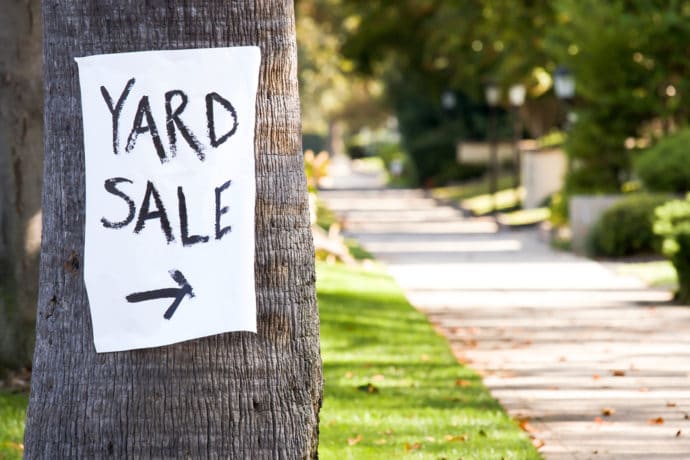
Has spring cleaning left you with lots of items that you no longer need or want? Are you unable to find places to put your new purchases? Are you parking in the driveway because your garage is used for storage? If you are currently experiencing any of these, it might be time for a yard sale.
Planning
Decide on a Date. The first part of planning will be to pick a date and time for your yard sale. You can do a single day, or several days depending on how much stuff you wish to get rid of and your schedule. Yard sales are most commonly held on weekends and during the spring and summer months.
Collect Your Goods. Gather up everything that you would like to sell. Go to each room in your house and look for things that no longer serve a purpose or don’t fit your current design aesthetic. Open each closet and purge it of clothes that haven’t been worn in more than a year or no longer fit correctly. Take the same approach to every part of your house, including the attic, garage, basement, and cupboards.
Get the Word Out. Tell your friends and family that you’re having a yard sale and have them help get the word out. Advertise on social media, including Facebook resell and neighborhood pages, Craigslist, and local yard sale sites. You might want to do a printed or online ad with your local newspaper if you have lots of stuff to sell or several high value items you want top dollar for. Make signs that tell when and where the yard sale is. If your location is hard to find, be sure to have some arrow signs to point everyone in the direction of your sale.
Payment Options. Have plenty of change on hand. Be sure to grab some rolls of quarters and plenty of small bills prior to the sale. You might even consider taking electronic payments via a card reader connected to your smartphone or tablet.
Set Your Prices. Price your larger and more expensive items individually. Think about what you would consider paying for the same item at a yard sale and price accordingly. The purpose of the yard sale is to make some cash while getting rid of things you no longer need or want. If you price things too high, you might not sell anything. Smaller, cheaper items can be placed in boxes marked with the price per item.
Let’s Make a Deal.
Time to Setup. On the day of the yard sale, get up a couple hours before your start time to begin setting up. Tables and clothes racks make it easier for people to shop and spend time looking at your items than when they are all on the ground or still in boxes. Have dedicated areas for each category, such as clothing, kitchen items, electronics, toys, etc.
Be Flexible on Prices. Once the sale has started, get ready for the bargaining to begin. If someone is indecisive, make them an offer lower than your listed price. Give discounts to those purchasing multiple items and be more willing to accept lower prices as time goes on and your sale is drawing to a close. If you are nearing the end of the sale and have lots still to sell, consider doing a set price for as many items as people can place into a plastic shopping bag.
Packing Up the Leftovers. Once your yard sale has ended, you will likely still have items left that did not sell. Consider donating these to a charity or thrift store, rather than bringing them back into your house. Some places will come to your house and pick up large items, but most smaller items will need to be dropped off.
Having a successful yard sale requires time, which will be spent planning and conducting the sale, but it is a great way to get some cash for items that are no longer serving a purpose in your house. Hopefully these tips will help you clear some clutter and give you some extra spending money this summer.



